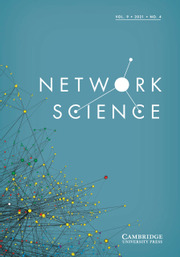Crossref Citations
This article has been cited by the following publications. This list is generated based on data provided by
Crossref.
Leifeld, Philip
2015.
Downing, Stephen T.
Kang, Jin-Su
and
Markman, Gideon D.
2019.
What You Don’t See Can Hurt You: Awareness Cues to Profile Indirect Competitors.
Academy of Management Journal,
Vol. 62,
Issue. 6,
p.
1872.
Goritz, Alexandra
Kolleck, Nina
and
Jörgens, Helge
2019.
Education for Sustainable Development and Climate Change Education: The Potential of Social Network Analysis Based on Twitter Data.
Sustainability,
Vol. 11,
Issue. 19,
p.
5499.
Abramski, Katherine
Katenka, Natallia
and
Hutchison, Marc
2020.
Complex Networks and Their Applications VIII.
Vol. 882,
Issue. ,
p.
387.
Stivala, Alex
2020.
Reply to “Comment on Geodesic Cycle Length Distributions in Delusional and Other Social Networks”.
Journal of Social Structure,
Vol. 21,
Issue. 1,
p.
94.
Martin, John Levi
2020.
Comment on Geodesic Cycle Length Distributions in Delusional and Other Social Networks.
Journal of Social Structure,
Vol. 21,
Issue. 1,
p.
77.
Leifeld, Philip
2020.
Handbuch Methoden der Politikwissenschaft.
p.
573.
Hamilton, David G.
Jones, Menna E.
Cameron, Elissa Z.
Kerlin, Douglas H.
McCallum, Hamish
Storfer, Andrew
Hohenlohe, Paul A.
and
Hamede, Rodrigo K.
2020.
Infectious disease and sickness behaviour: tumour progression affects interaction patterns and social network structure in wild Tasmanian devils.
Proceedings of the Royal Society B: Biological Sciences,
Vol. 287,
Issue. 1940,
p.
20202454.
Malinovskaya, Anna
and
Otto, Philipp
2021.
Online network monitoring.
Statistical Methods & Applications,
Vol. 30,
Issue. 5,
p.
1337.
Ruck, Damian J.
Bentley, R. Alexander
and
Borycz, Joshua
2021.
Early warning of vulnerable counties in a pandemic using socio-economic variables.
Economics & Human Biology,
Vol. 41,
Issue. ,
p.
100988.
Xu, Yu
Hazée, Simon
So, Kevin Kam Fung
Li, K. Daisy
and
Malthouse, Edward Carl
2021.
An evolutionary perspective on the dynamics of service platform ecosystems for the sharing economy.
Journal of Business Research,
Vol. 135,
Issue. ,
p.
127.
Gillis, Darren M.
Rijnsdorp, Adriaan D.
and
Poos, Jan Jaap
2021.
Association networks in the Dutch offshore beam trawl fleet: their predictors and relationship to vessel performance.
Canadian Journal of Fisheries and Aquatic Sciences,
Vol. 78,
Issue. 7,
p.
924.
Xu, Yu
2022.
Evolution of audience duplication networks among social networking sites: Exploring the influences of preferential attachment, audience size, and niche width.
New Media & Society,
Vol. 24,
Issue. 9,
p.
2068.
Beardsley, Kyle
2022.
The Coevolution of Networks of Interstate Support, Interstate Threat and Civil War.
SSRN Electronic Journal ,
Corradi, Andrea
McMillan, Cassie
and
Dietrich, Nick
2022.
A hostile reputation: A social network approach to interstate hostility.
Social Networks,
Vol. 71,
Issue. ,
p.
61.
Liu, Linqing
Shen, Mengyun
Sun, Da
Yan, Xiaofei
and
Hu, Shi
2022.
Preferential attachment, R&D expenditure and the evolution of international trade networks from the perspective of complex networks.
Physica A: Statistical Mechanics and its Applications,
Vol. 603,
Issue. ,
p.
127579.
Leifeld, Philip
and
Cranmer, Skyler J.
2022.
A theoretical and empirical comparison of the temporal exponential random graph model and the stochastic actor-oriented model – Corrigendum.
Network Science,
Vol. 10,
Issue. 1,
p.
111.
Wasserman, Stanley
and
Brandes, Ulrik
2022.
Editors’ Note.
Network Science,
Vol. 10,
Issue. 1,
p.
1.
An, Weihua
Beauvile, Roberson
and
Rosche, Benjamin
2022.
Causal Network Analysis.
Annual Review of Sociology,
Vol. 48,
Issue. 1,
p.
23.
Shi, Xiaoyi
Huang, Xiaoxia
and
Liu, Huifang
2022.
Research on the Structural Features and Influence Mechanism of the Low-Carbon Technology Cooperation Network Based on Temporal Exponential Random Graph Model.
Sustainability,
Vol. 14,
Issue. 19,
p.
12341.



Target article
A theoretical and empirical comparison of the temporal exponential random graph model and the stochastic actor-oriented model
Related commentaries (2)
Circular specifications and “predicting” with information from the future: Errors in the empirical SAOM–TERGM comparison of Leifeld & Cranmer
The stochastic actor-oriented model is a theory as much as it is a method and must be subject to theory tests